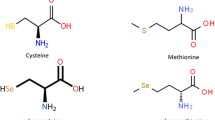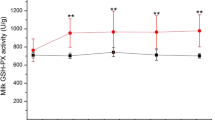Abstract
Trace amounts of selenium (Se) are essential for several organisms, and deficiencies therein have adverse effects on growth, development, and reproduction; this is particularly significant in animals raised for milk and livestock production. To study the effect of Se on Guanzhong dairy goats, their diets were supplemented with different sources (inorganic or organic) and Se concentrations (0.2 or 0.4 mg Se/kg). A non-Se-fortified basal diet served as a negative control, and a sixth treatment group received both inorganic and organic Se sources (0.2 mg Se/kg diet each). Dietary Se supplementation increased milk production, with organic Se being more effective than inorganic Se. Selenium supplementation also increased Se concentration and glutathione peroxidase activity in whole blood, with organic Se more effective than inorganic Se at the same Se concentration. With increasing Se in diets, the Se content in milk increased markedly, reaching a plateau value at day 30 in all groups, and organic Se (0.4 mg/kg diet) had the best effect. In addition, dietary Se sources and concentrations markedly affected Se concentrations in different tissues and organs. Thus, organic Se supplementation of a basal diet at 0.4 mg/kg is practically applicable for Se-enriched milk and meat production in Guanzhong dairy goats.
Similar content being viewed by others
References
Kieliszek M, Bzduchawróbel A, Kurcz A (2016) Effects of selenium on morphological changes in Candida utilis ATCC 9950 yeast cells. Biol Trace Elem Res 169(2):387
Navarro-Alarcon M, López-Martınez M (2000) Essentiality of selenium in the human body: relationship with different diseases. Sci Total Environ 249(1):347–371
Arthur J (2001) The glutathione peroxidases. Cell Mol Life Sci CMLS 57(13–14):1825–1835
McDowell LR (2003) Minerals in animal and human nutrition. vol Ed. 2. Elsevier Science BV,
Shini S, Sultan A, Bryden W (2015) Selenium biochemistry and bioavailability: implications for animal agriculture. Agriculture 5(4):1277–1288
Abutarbush SM, Radostits OM (2003) Congenital nutritional muscular dystrophy in a beef calf. Canadian Veterinary Journal La Revue Veterinaire Canadienne 44(9):738–739
Conor Reilly B.Sc. LP, H.Dip.Ed., PhD, FAIFST (2006) Selenium in food and health. Springer Berlin
Kinoshita H, Sugai K, Goto Y, Nonaka I (1995) Early onset distal muscular dystrophy. Brain Dev 17(3):206–209
Mora ML, Durán P, Acuña J, Cartes P, Demanet R, Gianfreda L (2014) Improving selenium status in plant nutrition and quality. Journal of Soil Science & Plant Nutrition 15 (ahead)
Scales GH (1974) Reproductive performance of merino ewes dosed with selenium prior to mating. Proc N Z Soc Anim Prod
Scales GH (1976) Selenium and beef cow fertility. N Z J Exp Agric 4(3):297–298
Balickaramisz A, Jastrzebski G (2014) Effect of selenium on the development of selected indicators of fertility in dairy cows. Veterinary World 7(10):863–867
Jovanović IB, Veličković M, Vuković D, Milanović S, Valčić O, Gvozdić, D (2012) Effects of different amounts of supplemental selenium and vitamin E on the incidence of retained placenta, selenium, malondialdehyde, and thyronines status in cows treated with prostaglandin F2α for the induction of parturition. J Vet Med 2013
Weiss WP, Eastridge ML (2005) Selenium sources for dairy cattle. Tri:61–71
Kommisrud E, Østerås O, Vatn T (2004) Blood selenium associated with health and fertility in Norwegian dairy herds. Acta Vet Scand 46(4):229–240
Mckenzie RC, Rafferty TS, Beckett GJ (1998) Selenium: an essential element for immune function. Immunol Today 19(8):342–345
Malbe M, Klaassen M, Fang W, Myllys V, Vikerpuur M, Nyholm K, Sankari S, Suoranta K, Sandholm M (1995) Comparisons of selenite and selenium yeast feed supplements on se-incorporation, mastitis and leucocyte function in se-deficient dairy cows. Zentralbl Veterinarmed A 42(2):111–121
Hogan JS, Weiss WP, Smith KL (1993) Role of vitamin E and selenium in host defense against mastitis 1. J Dairy Sci 76(9):2795–2803
Sharp BA, Van Dreumel AA, Young LG (1972) Vitamin E, selenium and methionine supplementation of dystrophogenic diets for pigs. Canadian journal of comparative medicine revue Canadienne de Médecine Comparée 36 (4):-
Sharp BA, Young LG, Van Dreumel AA (1972) Dietary induction of mulberry heart disease and Hepatosis Dietetica in pigs I. Nutritional aspects. Canadian Journal of Comparative Medicine Revue Canadienne De Medecine Comparee 36(4):371–376
Kieliszek M, Błażejak S (2013) Selenium: significance, and outlook for supplementation. Nutrition 29(5):713
Tufarelli V, Cazzato E, Ceci E, Laudadio V (2016) Selenium-fertilized tritordeum (× Tritordeum Ascherson et Graebner) as dietary selenium supplement in laying hens: effects on egg quality. Biological Trace Element Research:1–6
Rayman MP (2000) The importance of selenium to human health. Lancet 356(9225):233–241
Zong-Yun XU (2007) Effects of se-yeast in dairy ration on somatic cell and anti-oxidation performance. Chinese Journal of Animal Nutrition
Gong J, Ni L, Wang D, Shi B, Yan S (2014) Effect of dietary organic selenium on milk selenium concentration and antioxidant and immune status in midlactation dairy cows. Livest Sci 170(1):84–90
Pechová A, Antošová L, Pavlata L, Podhorský A (2015) Effect of sodium selenite or lactate-protein selenium complex supplementation on selenium status in goat kids. Czech Journal of Animal Science 60(1):16–24
Alhidary IA, Shini S, Al Jassim RA, Abudabos AM, Gaughan JB (2015) Effects of selenium and vitamin E on performance, physiological response, and selenium balance in heat-stressed sheep. J Anim Sci 93(2):576
Ghany-Hefnawy AE, López-Arellano R, Revilla-Vázquez A, Ramírez-Bribiesca E, Tórtora-Pérez J (2007) The relationship between fetal and maternal selenium concentrations in sheep and goats. Small Rumin Res 73(1–3):174–180
Zhao G-H, Zhang M-T, Lei L-H, Shang C-C, Cao D-Y, Tian T-T, Li J, Xu J-Y, Yao Y, Chen D-K (2011) Seroprevalence of toxoplasma gondii infection in dairy goats in Shaanxi Province, northwestern China. Parasit Vectors 4:47
Bogumiła P, Agnieszka T, Anna M, Marta W, Renata P, Jerzy W, Aleksandra B, Małgorzata B, Izabela D (2009) Selenium content in selected products of animal origin and estimation of the degree of cover daily Se requirement in Poland. N Engl J Med 45(1):186–191
Hong Y-B, Wei-Li Q, Hong C-D (2013) Oxidative stress induces gastric submucosal arteriolar dysfunction in the elderly. World J Gastroenterol 19(48):9439–9446
Salman S, Dinse D, Khol-Parisini A, Schafft H, Lahrssen-Wiederholt M, Schreiner M, Scharek-Tedin L, Zentek J (2013) Colostrum and milk selenium, antioxidative capacity and immune status of dairy cows fed sodium selenite or selenium yeast. Arch Anim Nutr 67(1):1428–1429
Tufarelli V, Laudadio V (2011) Dietary supplementation with selenium and vitamin E improves milk yield, composition and rheological properties of dairy Jonica goats. J Dairy Res 78(2):1–5
Juniper DT, Phipps RH, Jones AK, Bertin G (2006) Selenium supplementation of lactating dairy cows: effect on selenium concentration in blood, milk, urine, and feces. J Dairy Sci 89(9):3544–3551
Heard J, Stockdale C, Walker G, Leddin C, Dunshea F, McIntosh G, Shields P, McKenna A, Young G, Doyle P (2007) Increasing selenium concentration in milk: effects of amount of selenium from yeast and cereal grain supplements. J Dairy Sci 90(9):4117–4127
Kieliszek M, Błażejak S (2016) Current knowledge on the importance of selenium in food for living organisms: a review. Molecules 21(5):609
Phipps RH, Grandison AS, Jones AK, Juniper DT, Ramos-Morales E, Bertin G (2008) Selenium supplementation of lactating dairy cows: effects on milk production and total selenium content and speciation in blood, milk and cheese. Animal 2(11):1610–1618
Calamari L, Petrera F, Bertin G (2010) Effects of either sodium selenite or Se yeast (Sc CNCM I-3060) supplementation on selenium status and milk characteristics in dairy cows. Small Rumin Res 128(1–3):154–165
Bruzelius K, Sundler R, Pagmantidis V, Akesson B (2010) Regulation of selenoprotein mRNA expression by hormones and retinoic acid in bovine mammary cells. J Trace Elem Med Biol 24(4):251–256
Bruzelius K, Purup S, James P, Onning G, Akesson B (2008) Biosynthesis of selenoproteins in cultured bovine mammary cells. J Trace Elem Med Biol 22(3):224–233
Hadley KB, Sunde RA (2001) Selenium regulation of thioredoxin reductase activity and mRNA levels in rat liver. Journal of Nutritional Biochemistry 12(12):693–702
Sunde RA, Raines AM, Barnes KM, Evenson JK (2009) Selenium status highly regulates selenoprotein mRNA levels for only a subset of the selenoproteins in the selenoproteome. Biosci Rep 29(5):329–338
Weiss WP, Hogan JS (2005) Effect of selenium source on selenium status, neutrophil function, and response to intramammary endotoxin challenge of dairy cows. J Dairy Sci 88(12):4366–4374
Gunter SA, Beck PA, Hallford DM (2013) Effects of supplementary selenium source on the blood parameters in beef cows and their nursing calves. Proc Natl Acad Sci 152(2):204–211
Slavik P, Illek J, Brix M, Hlavicova J, Rajmon R, Jilek F (2008) Influence of organic versus inorganic dietary selenium supplementation on the concentration of selenium in colostrum, milk and blood of beef cows. Acta Vet Scand 50(1):43
Beilstein MA, Whanger PD (1986) Deposition of dietary organic and inorganic selenium in rat erythrocyte proteins. J Nutr 116(9):1701–1710
Thiry C, Schneider YJ, Pussemier L, Temmerman LD, Ruttens A (2013) Selenium bioaccessibility and bioavailability in Se-enriched food supplements. Biol Trace Elem Res 152(1):152–160
Zheng LY, Zhang Q, Liu BT, Guo K, Wen-Lan YU, Liu ZW, Chen Y, Guo CL, Tang ZX (2013) Effect of different dietary selenium concentration on mRNA levels of some Selenoprotein in mice liver and testis. China Animal Husbandry & Veterinary Medicine 40(3):38–42
Humann-Ziehank E, Renko K, Mueller AS, Roehrig P, Wolfsen J, Ganter M (2013) Comparing functional metabolic effects of marginal and sufficient selenium supply in sheep. Journal of Trace Elements in Medicine & Biology Organ of the Society for Minerals & Trace Elements 27(4):380–390
Acknowledgements
This study was supported by the “13115” Sci-Tech Innovation Program of Shaanxi Province (2009ZDKG-19).
Author information
Authors and Affiliations
Corresponding author
Rights and permissions
About this article
Cite this article
Zhang, L., Liu, X.R., Liu, J.Z. et al. Supplemented Organic and Inorganic Selenium Affects Milk Performance and Selenium Concentration in Milk and Tissues in the Guanzhong Dairy Goat. Biol Trace Elem Res 183, 254–260 (2018). https://doi.org/10.1007/s12011-017-1112-1
Received:
Accepted:
Published:
Issue Date:
DOI: https://doi.org/10.1007/s12011-017-1112-1




